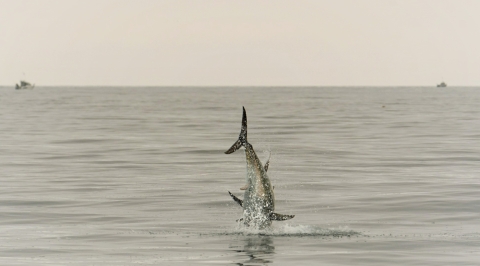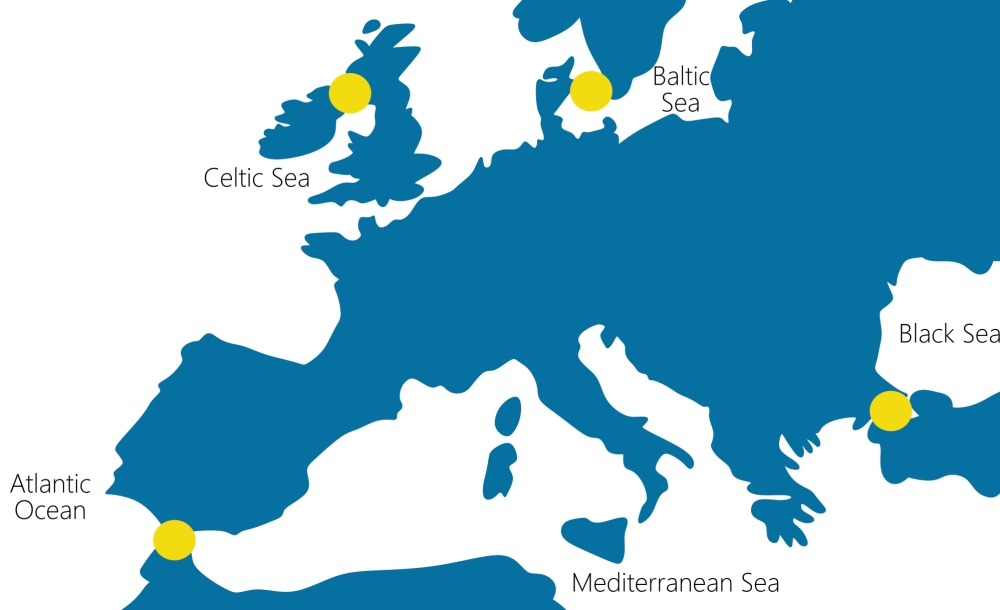3.5 million project aims to solve mysteries about fish migration through main European swimways
A new EU-funded project, STRAITS, will equip all four corners of Europe to track aquatic life in an effort to better understand their biology and ecology, and aid in conservation and management.

Article based on press release of Flanders Marine Institute (VLIZ) and press release of Technical University of Denmark (DTU).
STRAITS – Strategic Infrastructure for improved animal Tracking in European Seas – is a four-year project funded by the Horizon Europe Framework Program, under the call “Developing the European research infrastructures landscape, maintaining global leadership”, that will equip major swimways across Europe with equipment to monitor the movements of aquatic animals at a pan-European scale. STRAITS will deploy acoustic telemetry arrays in four major swimways in Europe 1) the Danish Straits, between the Kattegat Sea and the Baltic Sea, 2) the North Channel in the Celtic Sea, 3) the Strait of Gibraltar, between the Atlantic Ocean and the Mediterranean Sea, and 4) the Strait of Bosphorus and Dardanelles, between the Mediterranean Sea and the Black Sea (see map).
In our country, previous initiatives investigated the 'where-abouts' of fish (but also lobsters, crabs and even plastics) by attaching receivers on or in the animal and capturing the emitted sound signals. Thus, the Flanders Marine Institute (VLIZ) and the Research Institute for Nature and Forest (INBO) developed a network of more than 160 receiving stations in the Belgian part of the North Sea and the neighbouring Scheldt estuary, as part of the LifeWatch project. This provided interesting insights on the movements of 16 fish species, both fresh, salt and migratory (including cod, plaice, eel, sea bass, red mullet and spotted smooth shark). Dr Jan Reubens of VLIZ and national contact for this fish tag initiative, explains, "Our network allows us to track the animals in their natural habitat and this has already given us many interesting and surprising results that contribute to species management and protection."

The new STRAITS project builds on this, as well as on actions by the European Tracking Network (www.europeantrackingnetwork.org), a pan-European collaboration of experienced researchers using shared intelligent equipment. STRAITS will also leverage ongoing acoustic telemetry tracking projects, expand efforts to connect tracking initiatives from across Europe, develop data management plans and networking to promote synergy, and deliver data to national and international governing bodies.
Animal tracking – the study of animal movements– offers one of the best ways to monitor animals from regional to continental or even global scales, and from minutes to decades. Although animal tracking is not new, it is only recently that the technology has enabled the tracking of animals over larger areas and longer timescales. This advancement has yielded key information about the biology and ecology of these animals, but much more knowledge could be gained if efforts to tag and detect animals were performed collaboratively, as part of a network. This is one of the primary goals of STRAITS.
“With this project, all aquatic life in Europe gains. STRAITS will allow to better determine migration routes, estimate survival and locate spawning grounds. But it will also address how different life stages follow each other and what threats are involved along the way, and lead to meaningful recommendations related to the protection of aquatic life." says Jan Reubens, science officer at VLIZ.
The STRAITS team consists of 10 world-leading organisations in the study of animal movement. Together, they will advance our understanding of aquatic animal movements in Europe and abroad, and change the way biodiversity is monitored in European waters, thereby contributing to conservation and policy initiatives.
To find out more, visit www.europeantrackingnetwork.org/straits
Link animation 'acoustic telemetry'
Video: Acoustic Telemetry - how it works and why it's useful on YouTube
Press contacts
Photo credit: Bluefin Tuna by Kim Birnie-Gauvin
STRAITS – Strategic Infrastructure for improved animal Tracking in European Seas – is a four-year project funded by the Horizon Europe Framework Program, under the call “Developing the European research infrastructures landscape, maintaining global leadership”, that will equip major swimways across Europe with equipment to monitor the movements of aquatic animals at a pan-European scale. STRAITS will deploy acoustic telemetry arrays in four major swimways in Europe 1) the Danish Straits, between the Kattegat Sea and the Baltic Sea, 2) the North Channel in the Celtic Sea, 3) the Strait of Gibraltar, between the Atlantic Ocean and the Mediterranean Sea, and 4) the Strait of Bosphorus and Dardanelles, between the Mediterranean Sea and the Black Sea (see map).
In our country, previous initiatives investigated the 'where-abouts' of fish (but also lobsters, crabs and even plastics) by attaching receivers on or in the animal and capturing the emitted sound signals. Thus, the Flanders Marine Institute (VLIZ) and the Research Institute for Nature and Forest (INBO) developed a network of more than 160 receiving stations in the Belgian part of the North Sea and the neighbouring Scheldt estuary, as part of the LifeWatch project. This provided interesting insights on the movements of 16 fish species, both fresh, salt and migratory (including cod, plaice, eel, sea bass, red mullet and spotted smooth shark). Dr Jan Reubens of VLIZ and national contact for this fish tag initiative, explains, "Our network allows us to track the animals in their natural habitat and this has already given us many interesting and surprising results that contribute to species management and protection."

The new STRAITS project builds on this, as well as on actions by the European Tracking Network (www.europeantrackingnetwork.org), a pan-European collaboration of experienced researchers using shared intelligent equipment. STRAITS will also leverage ongoing acoustic telemetry tracking projects, expand efforts to connect tracking initiatives from across Europe, develop data management plans and networking to promote synergy, and deliver data to national and international governing bodies.
Animal tracking – the study of animal movements– offers one of the best ways to monitor animals from regional to continental or even global scales, and from minutes to decades. Although animal tracking is not new, it is only recently that the technology has enabled the tracking of animals over larger areas and longer timescales. This advancement has yielded key information about the biology and ecology of these animals, but much more knowledge could be gained if efforts to tag and detect animals were performed collaboratively, as part of a network. This is one of the primary goals of STRAITS.
“With this project, all aquatic life in Europe gains. STRAITS will allow to better determine migration routes, estimate survival and locate spawning grounds. But it will also address how different life stages follow each other and what threats are involved along the way, and lead to meaningful recommendations related to the protection of aquatic life." says Jan Reubens, science officer at VLIZ.
The STRAITS team consists of 10 world-leading organisations in the study of animal movement. Together, they will advance our understanding of aquatic animal movements in Europe and abroad, and change the way biodiversity is monitored in European waters, thereby contributing to conservation and policy initiatives.
To find out more, visit www.europeantrackingnetwork.org/straits
Link animation 'acoustic telemetry'
Video: Acoustic Telemetry - how it works and why it's useful on YouTube
Press contacts
- Jan Seys, spokesperson VLIZ, jan.seys@vliz.be | +32-(0)478-37 64 13
- Jan Reubens, researcher VLIZ, jan.reubens@vliz.be | +32-(0)486-14 80 35
Photo credit: Bluefin Tuna by Kim Birnie-Gauvin



